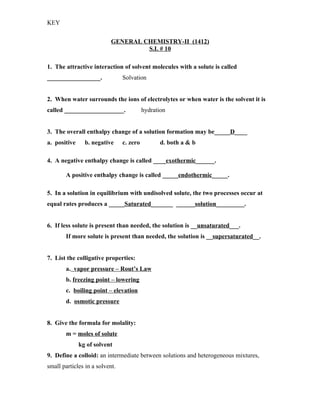#10 Key
•Als DOC, PDF herunterladen•
1 gefällt mir•7,903 views
This document provides definitions and examples of key concepts in general chemistry including: 1. Solvation refers to the attractive interaction between solvent molecules and a solute. Hydration describes the interaction when water is the solvent. 2. The overall enthalpy change of a solution can be either positive (endothermic) or negative (exothermic). 3. A saturated solution is one in equilibrium with undissolved solute where dissolution and crystallization occur at equal rates. Unsaturated and supersaturated solutions contain less or more solute respectively. 4. Colligative properties include vapor pressure depression, freezing point depression, boiling point elevation, and osmotic pressure.
Melden
Teilen
Melden
Teilen

Empfohlen
Empfohlen
Weitere ähnliche Inhalte
Was ist angesagt?
Was ist angesagt? (20)
Local and Global Communication in Multicultural Setting

Local and Global Communication in Multicultural Setting
Myca's Report: Ang Paraan ng Paglikom ng Datos and Paraan ng Pagsusuri ng Datos

Myca's Report: Ang Paraan ng Paglikom ng Datos and Paraan ng Pagsusuri ng Datos
IKALAWANG PAGLALAKBAY SA EUROPA NI RIZAL by Lorraine Anoran

IKALAWANG PAGLALAKBAY SA EUROPA NI RIZAL by Lorraine Anoran
DepEd SHS STEM General Chemistry Modules Quarters 1-2 by CDO

DepEd SHS STEM General Chemistry Modules Quarters 1-2 by CDO
Ähnlich wie #10 Key
Ähnlich wie #10 Key (20)
Chapter 13 Lecture on Solutions & Colligative Properties

Chapter 13 Lecture on Solutions & Colligative Properties
Mehr von jessieo387_1412
#10 Key
- 1. KEY GENERAL CHEMISTRY-II (1412) S.I. # 10 1. The attractive interaction of solvent molecules with a solute is called _________________. Solvation 2. When water surrounds the ions of electrolytes or when water is the solvent it is called ___________________. hydration 3. The overall enthalpy change of a solution formation may be_____D____ a. positive b. negative c. zero d. both a & b 4. A negative enthalpy change is called ____exothermic______. A positive enthalpy change is called _____endothermic_____. 5. In a solution in equilibrium with undisolved solute, the two processes occur at equal rates produces a _____Saturated_______ ______solution_________. 6. If less solute is present than needed, the solution is __unsaturated___. If more solute is present than needed, the solution is __supersaturated__. 7. List the colligative properties: a. vapor pressure – Rout’s Law b. freezing point – lowering c. boiling point – elevation d. osmotic pressure 8. Give the formula for molality: m = moles of solute kg of solvent 9. Define a colloid: an intermediate between solutions and heterogeneous mixtures, small particles in a solvent.
- 2. KEY 10. Water and glycerol, CH2(OH)CH(OH)CH2OH are miscible in all proportions. What does this mean? How do the OH groups of the alcohol molecule contribute to this miscibility? Water and glycerol form homogeneous mixtures regardless of starting amount. Glycerol has strong hydrogen bonding from the (OH) groups like water. “Likes dissolve likes” and the two liquids are miscible. 11. A) Calculate the mass percent of Na2SO4 in a solution containing 10.6 g of Na2SO4 in 483 g of water. B) An ore contains 2.86 g of silver per ton of ore. What is the concentration of silver in ppm? A) mass % = mass of solute x 100 = 10.6 g Na2SO4 x 100 = 2.15% Total mass of solution (10.6 g Na2SO4 + 483 g H2O) B) ppm = mass of solute x 106 = (2.86 g Ag)(1ton)(1 lb) x 106 = 3.15 ppm Total mass of solution (1ton ore)(2000lb)(453.6g) 12. Calculate the molality of each: a. 8.66 g benzene (C6H6) dissolved in 23.6 g CCl4 b. 4.80 g NaCl dissolved in 0.350 L of water a. m = mol solute; 8.66 g C6H6 x 1mol C6H6 x 1000 g CCl4 = 4.70 m C6H6 kg solvent 23.6gCCl4 78.11g C6H6 1kg CCl4 b. the density of H2O = 0.997 g/mL = 0.997 kg/L 4.80 g NaCl x 1 mol NaCl x 1 L H2O = 0.235 m NaCl 0.350 L H2O 58.44 g NaCl 0.997 kg H2O